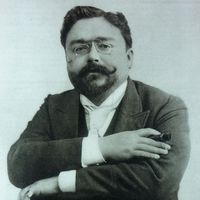Isaac Albéniz (29.05.1860–18.05.1909)
Isaac Manuel Francisco Albéniz was a Spanish composer and pianist. In Leipzig he studied under Carl Reinecke (1824–1910) at the conservatory for two months in 1876.

1. Biography
Isaac Albéniz was born on May 29th, 1860 in Camprodón (Girona province, Spain) as the youngest of four children of Ángel Lucio Albéniz y Gauna and Dolores Pascual i Bardera. Albéniz’ father was of Basque origin and worked as a customs officer near the French border; his mother was Catalan. At the end of 1863 the family moved to Barcelona. Here Albéniz received his first professional piano lessons from Narciso Oliveras and played his first public concert in the Teatro Romea at the age of four. For this performance his parents dressed him as a musketeer. Still a child, Albéniz repeatedly ran away from home and survived by playing concerts. At the age of twelve he hid as a stowaway on a ship to Puerto Rico, and later travelled this way to Buenos Aires and Havana. His father tracked him down in Cuba but allowed Albéniz to go on to New York on his own. He was admired in the concerts he played, especially since he apparently often spiced up his performances with special tricks such as playing with the backs of his fingers. When he was 14 he also made a stop in San Francisco. From there he returned to Europe.
In May 1876 Albéniz enrolled in the Leipzig Conservatory and for two months studied composition under Carl Reinecke (1824-1910). In 1876 he continued his studies at the Brussels Royal Conservatory with the financial aid of the Spanish king Alfonso XII and graduated with distinction. In 1883 Albéniz moved to Barcelona and again studied composition. From 1886 to 1889 Albéniz lived in Madrid to teach, play concerts, and compose.
As a pianist Albéniz went on concert tours to England, Germany, Austria and Belgium several times. He was celebrated as one of the greatest pianists of his time. In 1894 he moved to Paris, where he met famous musicians such as Vincent d’Indy, Paul Dukas, Ernest Chausson, Gabriel Fauré and César Franck. Through their influence his style of composition changed. In 1903 his family moved to Nice. During this time, between 1905 and 1909, he composed his most famous piano work Iberia.
Isaac Albéniz died on May 18th, 1909 in Cambo-les-Bains in the French Pyrenees, his last residence. His body was transferred to Barcelona and buried at the Montjuïc cemetery.
2. Private Life
In 1883 Albéniz married his student Rosita Jordana. The pair had five children: Blanca (who died in 1886), Laura, who later became a famous painter, and Alfonso; two more children died as infants. Until 1885 the family lived in Barcelona. Albéniz was a charming, generous and humorous person, who was able to make friends and establish useful connections. Even though he never received a longer, profound education – besides his studies of music – he was well read, spoke several languages and had a keen interest in politics and philosophy.
3. Connection to Leipzig
On May 2nd, 1876 Albéniz enrolled at the Leipzig Conservatory to study composition under Salomon Jadassohn and Carl Reinecke. He stayed here for only two months until June 24th, 1876 and attended courses in music theory, composition, piano, chamber music, and singing. A music teacher at St. Thomas School, Dr. Bräutigam, at whose house Albéniz lived at Johann-Sebastian-Bach Strasse 57, paid for his study fees. He also acted as a kind of guardian to the barely 16-year-old and handed him the money his father had sent to him from Spain. Albéniz’ educational performance at the conservatory was considered to be inadequate. He might have been bored by the technical studies, but the main reason was probably his difficulty in communicating during the lessons due to his lacking knowledge of the German language. Therefore, he often skipped the theoretical lessons and finally aborted this intermezzo in Leipzig after only a short period of time.
In October 1876 he continued his studies at the Royal Conservatory in Brussels, where he studied piano with Louis Brassin and won a price with distinction in a piano competition in 1879. In the summer of 1880 he met Franz Liszt in Budapest.
While in Leipzig Albéniz composed so-called Zarzuelas, little piano pieces in a Spanish style. During this time, he also seemed to have already worked on music for some libretti he had received from a rich English amateur.
4. Reception
The high regard with which Albéniz was held by his contemporaries, particularly in France, was not only caused by his virtuosity, his brilliant interpretations of the traditional repertoire, or the originality of his own compositions but also by his humorous and charming personality. While his compositions where strongly influenced by the landscapes and sounds of Spain, he preferred to live outside his home country, from which he felt estranged. His notes on events in his life, his friends, his travels to America and last but not least his studies are often contradictory. But his influence on the development of Spanish music was extensive. As a conductor, interpreter, and composer he contributed significantly to its dissemination on a national and international level and promoted a number of Spanish musicians.
5. Works
Operas
1892: The Magic Opal, (premiere January 19th, 1893), London, Lyric Theatre
1897–1902: Merlin, (premiere May 28th, 2003), Madrid, Teatro Real
1893–1895: Henry Clifford, (premiere May 8th, 1895), Barcelona, Gran Teatro del Liceo
Zarzuelas
1894: San Antonio de la Florida
Piano Pieces
1886: Suite española (Spanish suite) op.47, suite for piano with 8 pieces: Granada, Cataluña, Sevilla, Cádiz, Asturias, Aragón, Castilla and Cuba
1905–1909: Iberia, suite for piano with 12 pieces in 4 volumes
Audio Samples
Suite espaniola (Spanish suite) op.47 (1886) https://www.youtube.com/watch?v=pssZnVi_h2I
Iberia (Buch 1 und 2) (1905-1909) https://www.youtube.com/watch?v=XQZjSvI7kfw
San Antonio de la Florida (1894) www.youtube.com/watch
6. Sources and Links
Clark, Walter A.: Isaac Albéniz. Portrait of a romantic, Oxford University Press 2002.
Finscher, Ludwig (ed.): Die Musik in Geschichte und Gegenwart, Personenteil, 2nd revised edition, Kassel a. o. 2003.
http://www.allmusic.com/artist/isaac-alb%C3%A9niz-mn0000759834/biography
https://www.swr.de/-/id=4605430/property=download/nid=659552/gfhlje/swr2-musikstunde-20090516.pdf
Photo
de.wikipedia.org/wiki/Isaac_Alb%C3%A9niz // Von Esplugas, upload by Adrian Michael - Die berühmten Musiker Kunstverlag Lucien Mazenod, Genf 1946, Gemeinfrei, httpscommons.wikimedia.orgwindex.phpcurid=10600284




